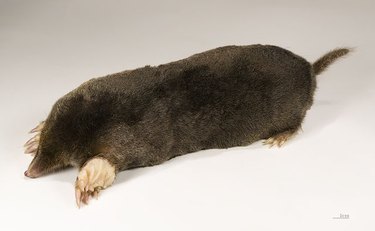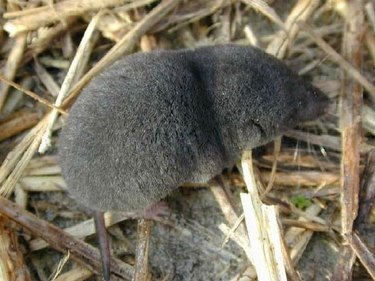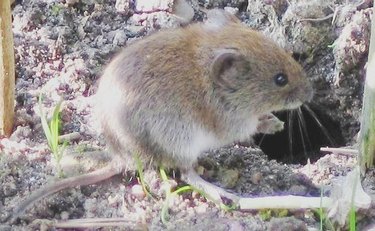
If you think you have a mole in your home, chances are....you don't.
That pesky varmint you see scurrying under your cabinets and pilfering your food almost certainly is not a mole. With sightless eyes and large, paddle-like front feet, moles are highly specialized for life underground. The only circumstance that might result in a mole being in your house willingly would be the presence of a large indoor garden—which is where the mole would be. If you saw the critter come into your house from a tunnel, it could be a vole or a shrew. Otherwise, it's probably a mouse—by far the most common of small indoor varmints.
Video of the Day
Video of the Day
What's the Difference?
It's rare to see moles above-ground, but when one does occasionally poke its head up from a hole, its large snout, lack of visible eyes and ears, and large claws on the front feet make it easy to identify. The mole is a relatively large for a small animal, sometimes as large as 6 or 8 inches. It is pretty unmistakable and also very unlikely to be the critter you see inside your home. These are the pests that can leave raised trails through your lawn and garden, but it is extremely rare for them to venture indoors.

Shrews are smaller than moles—in fact, with a body length of 3 to 4 inches, they are among the world's smallest mammals. They have long snouts, dense fur, and small eyes. Although they don't make their own tunnels, shrews often seek food in abandoned mole tunnels. In appearance, shrews bear a closer resemblance to mice more than they do moles, though you may spot a shrew entering or leaving an abandoned mole tunnel.

With a body length of 4 to 6 inches, voles look even more like mice; in fact, they are often called _field mice_—although they aren't actually mice. Voles are burrowing rodents, but they are often content to use existing mole tunnels.

Of the three species, only voles are rodents (like mice). But unlike mice and shrews, voles are carnivorous, often eating grubs and other underground insect life.
Mole, Vole, and Shrew Control
On the off-hand chance that a mole gets into your house, keep in mind that it arrived here by mistake and that the mole would much rather be outside; the same is true for shrews and voles. Unlike mice and rats, these animals are more at home in the ground than they are in your walls, although an errant shrew or vole may take shelter in your insulation in winter to get out of the cold.
To encourage the critter to go back outside, put your food away—especially grains and vegetables— and leave a door ajar. If possible, arrange the furniture to create an easy-to-follow pathway to the door. If that doesn't work—and if you don't have a police cat—you can try trapping a shrew or a vole, although success at this will be a long shot.
Trapping Moles
There is really no way to trap a mole that's accidentally wandered inside, and you really don't even need to try. Just open the door and let it go outside, perhaps coaxing it with a broom if it seems confused. Once it figures out how to get there, the animal will be thrilled to escape.
Trapping Shrews
Like the lead character in a certain Shakespearean play, shrews are aggressive and pugnacious—never try to catch one by hand. It may well bite you, and because some shrews have toxins in their saliva, you don't want to give them the opportunity. Set conventional mousetraps along the walls in areas where the shrew has been seen, and bait the traps with peanut butter or oatmeal. You can also try live mousetraps. If you catch a shrew in a live trap, wear protective gloves when releasing it.
Trapping Voles
Voles look like mice, but they don't eat the same things, and so you might have trouble enticing one with bait. Forget cheese—a better bait for voles is peanut butter, oatmeal, or sunflower seeds. Set conventional or live mousetraps along the walls, then cross your fingers. The best outcome for you and the vole, however, is for the little varmint to vamoose through the door you left open.